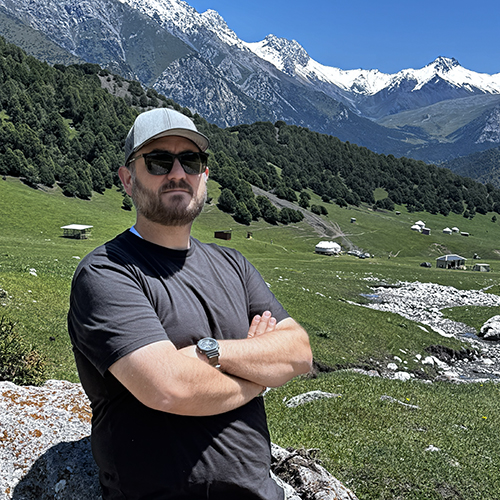At the end of World War II, several Brown Treesnakes—or possibly one pregnant female—slithered into the cargo hold of a military aircraft in the Admiralty Islands. When the plane landed in Guam, the snakes settled into the island’s forests, gobbling unsuspecting birds and their eggs. As the snake population swelled, the bird population dropped—precipitously.
Today native birds are virtually extinct on Guam, while neighboring islands in the Mariana Islands chain have thriving bird populations. Scientists in the Department of Biology are using this dramatic difference to study the importance of birds in forested and agricultural systems and the consequences of bird loss. The research, which began as Biology graduate student Haldre Rogers’s PhD thesis, is now supported by grants totaling nearly $1 million from the National Science Foundation (NSF) and the U.S. Department of Agriculture (USDA).

How could a renegade snake decimate an island’s bird population? The Brown Treesnake, nocturnal and well-camouflaged, was able to thrive and procreate over many years without anyone noticing. And the island’s native birds, having no prior experience with predators, were easy prey. They lacked the instinct to fly off when a snake approached.
“People monitoring the bird population would find a pattern of normal bird counts that would suddenly drop to nothing within a year,” says Rogers, “but they didn’t know why.” As the snakes expanded to new areas of the island, the drop in the bird population would be repeated. It wasn’t until the 1980s that the government identified the culprit. “It was unheard of, even among scientists, that a snake could cause extinctions,” explains Rogers.
By the time the snakes were discovered, controlling the snake population on Guam was no longer a realistic option. Instead the goal has been to prevent a similar devastation on neighboring islands. To this end, Rogers moved to Guam in 2002 as part of a U.S. Geological Survey team that travels to neighboring islands to search for and trap Brown Treesnakes when sightings are reported.
It was during those trips that Rogers formulated her idea for a research project. “I wondered why no one was studying the changes that result from bird extinctions,” she recalls. She recognized that the Mariana Islands, with both bird-rich and bird-free forests, provided an ideal natural laboratory. She enrolled in graduate school at the UW and shared her idea with Josh Tewksbury, assistant professor of biology. He was immediately intrigued. “No one was working on this question,” he says. “When I learned more about it, I realized we had to study the whole forest to understand the full impact. And I knew we couldn’t do this without substantial funding.”

With major grants secured, the research team now includes Rogers as project director, Tewksbury as project investigator, and Professors Janneke Hille Ris Lambers (UW) and Ross Miller (University of Guam) as co-investigators. In Guam there’s an on-site coordinator, a crew leader, and five field assistants, including a UW intern and recent graduates from the University of Guam and other U.S. schools. The team is exploring the impact of complete bird extinction on the 15 most common tree species in the Mariana Islands and on agricultural systems, where the loss of birds may increase the impact of insect pests.
“The question becomes, can trees and shrubs make it without birds? Are we looking at the potential extinction of most tree species on the island? No one knows,” says Tewksbury. “You wouldn’t want to wish this experiment on the world, but it’s there, so we should take advantage of it.”

Early results indicate that a lack of birds does impact seed dispersal in a big way. On Guam, seeds fall directly below a tree while on other islands they distribute throughout the forest. Whether that wider distribution presents a survival advantage for seedlings remains to be seen. “There’s reason to believe it provides an advantage, at least for some species, but we need to test that,” says Rogers.
There’s also the question of how traveling through a bird’s digestive tract impacts a seed’s viability. Tewksbury explains that the digestive process removes the husk and chemicals in a seed and “scarifies” or roughs up the seed in a way that may improve germination rates. “Depending on the species of plant, the digestive process may be very important or not important at all,” says Tewksbury. “Germination is a really complex process, and each species needs to be examined individually. Right now, we’re doing that work for all of our species—about 65 percent of the trees on the Mariana Islands.”
This winter, the team will also begin looking at agricultural impacts of bird extinction, comparing crops in areas with and without birds. The assumption is that birds control insects, and without birds there will be more insects damaging plants. But past studies suggest that Guam has not experienced a massive increase in insects. Its spider population, however, has exploded. “Spiders eat insects,” says Tewksbury, “so the question is, do they take the place of birds in controlling insects? We hope to at least quantify the pattern and then take it from there.”

With such a fascinating natural laboratory, the team has “millions of questions” they’d like to ask. The hardest part, says Tewksbury, has been to focus on a few that are doable. “I wish someone had started this study in the 1970s,” he says ruefully. “But we’ll have to start it where we are.”
More undergraduate students will participate next September, when the Department of Biology offers an Exploration Seminar, “Island Ecology and Conservation,” that will bring together students from the UW and the University of Guam to conduct an inter-island comparison of ecological issues. Rogers welcomes their observations. “There are so many questions to explore in the Marianas,” she says, “whatever they study is likely to be useful.”
For more about this research, visit http://faculty.washington.edu/tewksjj/ebl/index.shtml.
More Stories

Through Soil Science, an Adventure in Kyrgyzstan
Chemistry PhD alum Jonathan Cox spent most of 2025 in Kyrgyzstan, helping farmers improve their soil—and their crops—through soil testing.

A Sports Obsession Inspires a Career
Thuc Nhi Nguyen got her start the UW Daily. Now she's a sports reporter for Los Angeles Times, writing about the Lakers and the Olympics.

The Public Impact of Private Cities
Geography major Edwin Bai has researched private cities, developed by individuals and corporations, that "take the libertarian idea of low government regulation to the maximum."